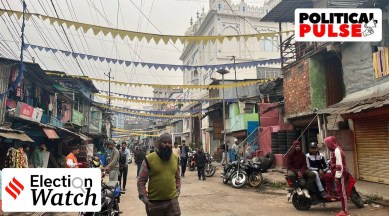The nowhere people of Shillong’s ‘Punjabi Lane’ see no hope from polls
Since the 2018 clashes between the Sikh residents here and the Khasi community, the area remains cordoned off, with barricades manned by CRPF.

On a recent February morning, it was business as usual in Shillong’s Punjabi Lane — pedestrians made their way past the many roadside vendors, women chatted in small groups, and young boys wolfed down ghugni (chickpeas). All of this was, however, done under the not-so-watchful eyes of a Central Reserve Police Force (CRPF) battalion stationed at the entrance to the lane.
For Jovanjeet Singh, 24, the presence of the men in uniform is a constant reminder of a violent week from five years ago. “Five years have gone by, but the area remains cordoned off… Even taxis are not allowed to ply here,” he said.
monthly limit of free stories.
with an Express account.
Beginning May 31, 2018, this colony of Dalit Sikhs was under siege for nearly a week after an altercation over a parking spot spiralled into full-fledged ethnic conflagration between the residents and the state’s Khasi community.
The clashes ended, but the fate of the community — which was first brought to Shillong by the British as manual scavengers and sweepers more than a hundred years ago — has remained in limbo.
Soon after the clashes, the National People’s Party (NPP)-led government in Meghalaya, under pressure from tribal groups, set the ball rolling to relocate the Dalit Sikhs from “Punjabi Lane”. Also known as Them lew Mawlong, the area is considered prized real estate as it is situated next to Shillong’s commercial hub and largest traditional market place, Iewduh or Bara Bazaar.
Clamour for the relocation had begun way before May 2018, but the ethnic clashes that year triggered what the community says has been their “worst five years” in recent memory.
“This government is against us. Of course, no political party will take our side, but the NPP government has been extreme,” said Jovanjeet, who is pursuing his master’s in Computer Application.
Ahead of the elections, though, Jovanjeet and his neighbours in Punjabi Lane have little hope that a change in government would make life any better for them.
“We do not expect much for anyone. Whichever political party comes to power will say the same thing – ‘these people need to be moved from here’,” said Gurjit Singh, president of the Harijan Panchayat Committee (HPC) that represents members of the Sikh Dalit community in Shillong.
Gurjit contested the legality of the government’s possession of the area’s land in October 2021, insisting that it was “gifted” to the Dalit Sikh community by the Syiem (chief) of Hima Mylliem – one of the chiefdoms in Khasi Hills – in the 1850s. The government, however, claims the land belongs to the Urban Affairs Department.
Several rounds of discussion since, the Sikhs agreed to relocate to the government-recommended European Ward, but with a condition that they had to be given land parcels and not quarters.
Gurjit, however, said the relocation has also been in limbo because “no one really wants to solve the issue”. “ If they do, it ceases being an issue,” he said.
R Singh, a 26-year-old businessman, said that the issue played into the state’s age-old ethnic “insider-outsider” fault lines, which helped “political parties electorally”. “In tribal areas, they bring our eviction up to get votes,” he said.
While most tribal political parties have over the years taken a hardline stance on the matter, the ruling NPP has been particularly “antagonistic” to the Dalit Sikhs, they claim. “It was very difficult in the last five years,” said Baljeet Kaur, a 38-year-old shopkeeper. “The entire incident was scary…but even after that the atmosphere of fear has continued…the government did nothing to make it better.”
Does that mean the Opposition stands to benefit? Not really, say the residents of Punjabi Line.
Even those canvassing for other parties ahead of the election seem to admit as much.
Khushi Randhawa, Muskan Kaur and Manpreet Kaur, three young students from Punjabi Line, recently joined the Trinamool Congress (TMC).
When The Indian Express met them, they were handing out flyers and pamphlets in the area. They said they joined the TMC because they were “impressed” by the “young woman candidate” – Elgiva Rynjah – the party had put up from North Shillong constituency, where Punjabi Lane falls.
“Ummeed hai [there is hope] that our issue will be solved but who knows what will happen in the future,” said Khushi.
The community accounts for around 1,200 votes in the small North Shillong constituency that comprises 25,000 voters. During their campaigns, most political parties have tried to court the community
“This number can actually make a difference because there are as many as eight candidates in a fray,” said Gurjit.
Ransom Sutnga, a retired government engineer contesting on an NPP ticket, said that “it may be true to some extent that it will be difficult to get votes in Punjabi Lane”. However, he claimed that he was personally reaching out to people. “The issue was taken up by our government, but considering it was ‘khichdi’ government — the NPP- BJP coalition — taking any decision was difficult. It is a sensitive issue and any resolution will involve all stakeholders and it should be in the interests of both the government and my friends living in Punjabi Lane,” he said.
Rynjah, also a first-time candidate, said that a “legislator alone can’t take a decision. “It is a humanitarian issue and we need to have expert communities.”
For the residents, though, the political rhetoric seemed to have inspired little confidence. “Only now they are talking about us. After the elections, we will be left to our own devices,” said R Singh.